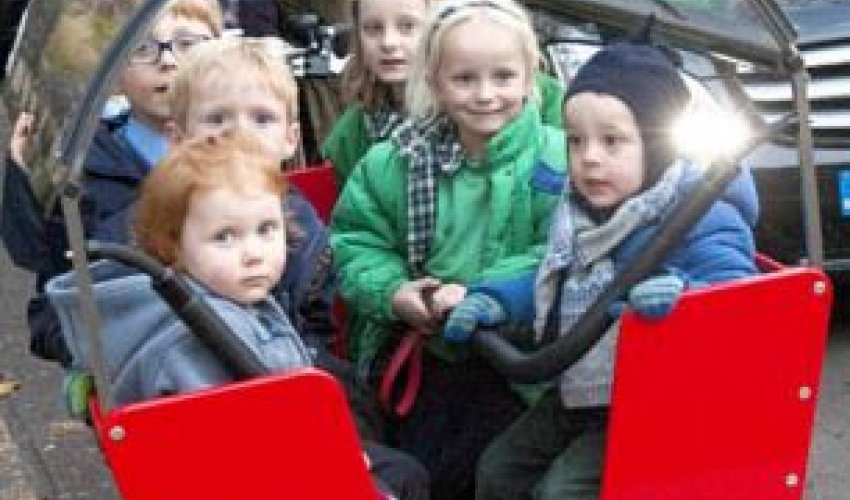Are you brave enough to swap the car for a bike crossed with a wheelbarrow? - PHOTO

Across the North Sea, they are as much a part of everyday life as being blond or eating herring or saying ‘hurdy-gurdy’. The Danes and the Dutch are mad about them, both claiming to have invented the idea, and the Swedes are fast catching up. Every morning in Copenhagen alone, 40,000 of them take to the streets. In Holland, the King uses one to do the school run.In fact, I’m surprised there isn’t already a cult Scandinavian TV drama featuring a brooding detective who drives a souped-up model with blue flashing light.Here in Britain, though, we remain less enthusiastic about the idea of swapping the family car for a bicycle crossed with a wheelbarrow. Maybe it’s because we have so many hills. Or so many deranged drivers. Or maybe it’s because we’re unwilling to spend upwards of £1,000 on a bike or trike with a box — a ‘cargo bike’ as they’re known in the trade. In fact, one new six-seater design has a price tag of £4,500. The Rolls-Royce of cargo bikes, it has an eight-speed gearbox, an electric booster and a roof.For now, these machines have a small but growing band of devotees in Britain, mainly in our more affluent — and flatter — urban neighbourhoods. But they are still a rarity — so much so that some people remain unconvinced.Hence this week’s news photo of a policeman stopping a cargo bike during the morning rush hour in North London.Ben Watson was taking his two daughters to school when he was pulled over. A recent spate of cycling fatalities in the capital has prompted extra vigilance from the authorities, but Mr Watson was rather irked when the officer asked: ‘Is that bike legal?’As he remarked later: ‘I thought: “Well, you’re the policeman. Surely you should be telling me whether it’s legal or not.” ’Mr Watson’s contraption is certainly legal. In fact, it happens to be exactly the same model — a £2,000 Bakfiets two-wheeler — as the one which King Willem-Alexander of the Netherlands uses to cart the young Princesses around The Hague.However, the harmless scene will have left many parents pondering the same question: Would you drive your children around in a pedal-powered crate? When I put the idea to my own daughters, the reply was unhesitating: ‘When are we getting one? It’s so much more exciting than going to school by car.’It turns out there are umpteen variations to choose from. Some, like Mr Watson and the Dutch King, prefer two wheels. Others, particularly those with larger families, want three. Some like to accommodate their passengers behind the driving seat; others want them in front.Then there’s the whole Dutch v Danish debate (there are one or two British makes, too). And for an extra £1,000 or so, there is the option of an electrical booster to help with hills and longer trips. I decide to test-drive a rather smart front-loading Dutch power trike. Instinctively, to me, three wheels seem safer than two. And I am all for a little cheating when it comes to forward motion.The next morning, there’s unprecedented enthusiasm for school in the Hardman household. Matilda, six, and Phoebe, four, are already on board doing up their seat-belts and waving hysterically at passers-by before I have even unlocked the thing. The one unexpected drawback of a trike is that it is more prone to capsizing than a bike when going round a corner. That’s because it is much easier to lean in to a turn on two wheels than on three. Turning sharply out of our house and over the kerb at the same time, I nearly tip us all straight into the road. The girls shriek with laughter.It’s surprisingly nimble on the flat but it’s too broad in the beam for any serious weaving through the West London rush-hour. If I try to follow the swoop of Lycra-lovers picking their way through the queues, there will be paintwork issues. Still, as we approach a traffic jam at Hammersmith, I do manage to overtake a few cars and we find ourselves alongside a police motorbike. Time for a Ben Watson-style encounter? Thankfully not. The officer could not be friendlier. He pulls up his visor, smiles at the girls and asks: ‘Is your taxi driver any good?’‘No!’ they yell in unison.Oddly, I don’t feel particularly vulnerable, even navigating this thing through a four-lane gyratory system. It feels high and wide enough to have a proper road presence, unlike an ordinary bike. But I miss the helpful punctuation of Radio 4’s Today programme on the car radio which usually dictates the pace of the school run. If we hear ‘Garry with the sport’, then it’s time to speed up. If we hear the 8.30 news headlines, then we know we’re in big trouble.Unsure of the time, I unleash the electric booster on the final furlong. Brilliant! All of a sudden, every push on the pedal is amplified two or threefold by a gizmo humming away near my feet. Suddenly, we’re going along at modest car speed. In no time, we are at the school gates. All in all, it’s been a pretty painless experience — but then it’s not raining and there haven’t been any nutters on the road this morning. I can certainly see the appeal of these machines in the right environment. In Denmark, they are marketed as the ‘new SUV’, an alternative to clunky ‘sport/utility vehicles’, a weekend runaround. In Greater Copenhagen, more than a quarter of all families with children own one. So why hasn’t Britain followed suit?This is, certainly, a golden age of British cycling, buoyed by Olympic triumphs and the Sir Bradley Wiggins factor. In London, millions have enjoyed the public rent-a-cycle scheme — dubbed ‘Boris bikes’ after their noisily velophile progenitor. In town and country, the bicycle spans all demographic divides, from wispy-bearded eco-zealot to Tory grandee. It was Andrew Mitchell’s attachment to his bike which caused the entire Plodgate scandal, after the former Chief Whip crossed swords with a policeman as he tried to wheel it through the Downing Street gates.Yet this surge in popularity has been accompanied by an inevitable rise in casualties. In London, half a dozen cyclists have been killed this month alone. Last year, across Britain, 118 were killed and 3,222 seriously injured.But it’s one thing to risk your own neck amid the juggernauts and boy racers; it’s another to throw your nearest and dearest into the mix. So what are the statistics on cargo bikes? According to the German Automobile Association, the cargo bike is easily the safest means of pedal-powered transport for a child, with its seatbelts and protective shell. And because it’s so large, it’s far easier for other traffic to spot it. There is nothing new about moving heavy loads on bicycles, of course. From fishmongers to ice-cream vendors to rickshaw drivers, people have been doing it for a century. But in recent years, a new conundrum has presented itself. On the one hand, modern family life has become increasingly dependent on the car, while on the other, modern urban planning policy has become increasingly anti-car. The cargo bike presents a solution of sorts.I travel to Cambridge — Britain’s cycling capital — where there’s actually a cargo bike showroom called the School Run Centre.Outside, I find every sort of pedal-powered family transport, including what can only be described as a stretch tandem (think of a stretch limo on two wheels), with room for an adult and up to four children. The price? A tyre-screeching £2,300. It would be cheaper to give each member of the family their own bike (plus a taxi for anyone feeling a bit weary).Hugh Salt, the founder and MD, says he has just sold one to a bike-mad family in London who use it for fun at weekends. ‘Car drivers are always going to be friendly to something that big,’ he says.But the really eye-catching machine is a £4,500, battery-assisted, six-seat Dutch monster called a De Redding. It’s more like a minibus than a trike, with two benches facing each other and a permanent roof. But surely it will require Olympic strength to shift one of these on the school-run?We give it a go. My daughters are beside themselves with excitement. Their two-year-old brother insists on clambering inside for the ride. No matter. By the time we get under way, I have somehow acquired seven passengers.‘Good luck!’ shouts a passing parent with a solitary child on a scooter, clearly convinced that I am never going to shift this thing. It’s not unlike a car, with its handbrake, square steering wheel and headlights. But it trundles off speedily enough as I start working my way up through the gears.‘Faster! Faster!’ comes the ungrateful chant from inside.Out on the main road, I press the electric booster button and we are suddenly sailing along. I notice that everyone on the pavement is smiling. Many are waving. It’s not often you see quite such a happy sight on the Queen’s highway.Now, I have no doubt that some parents would never dream of putting their children in one of these things and setting off down a main road. It might be good for the planet, and small passengers certainly love it. But it’s not cheap, and it’s not for everyone.Mrs Hardman wobbled all of 50 yards down the road before demanding the car keys. As for me, if they could just get around to installing a radio, I might be converted.(dailymail.co.uk)ANN.Az
Similar news
Similar news
Latest news 
More news 



































 Photo
Photo 



 Video
Video 

